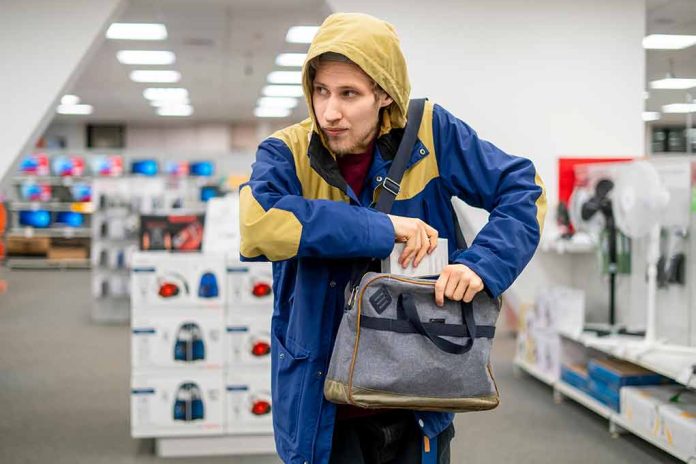
Juveniles as young as 12 from Venezuelan migrant gangs are assaulting NYPD officers in Times Square while exploiting New York’s lenient juvenile justice laws to avoid consequences for their escalating criminal activities.
Key Takeaways
- Five members of the migrant youth gang Los Diablos 42, linked to the Venezuelan gang Tren de Aragua, were arrested for assaulting police officers in Times Square during an attempted “wolf pack style robbery.”
- New York’s “Raise the Age” law is being exploited by gangs who recruit minors knowing they’ll face minimal consequences in Family Court rather than adult criminal courts.
- Gun arrests involving suspects under 18 have increased from 7% in 2018 to 12% in 2023, with some juvenile offenders being arrested dozens of times without meaningful intervention.
- NYPD officials are fighting to preserve their gang database while City Council considers abolishing it, creating tension over public safety approaches.
- Juvenile detention facilities like Brooklyn’s Crossroads Juvenile Center are overcrowded as repeat offenders cycle through the system without rehabilitation.
Times Square’s Juvenile Crime Wave
The heart of New York City has become a hunting ground for a particularly troubling criminal enterprise: juvenile migrant gangs exploiting legal loopholes. Five members of Los Diablos 42, an adolescent offshoot of the notorious Venezuelan gang Tren de Aragua, were recently arrested for assaulting NYPD officers during an attempted robbery in Times Square. The attack involved makeshift weapons and occurred during what police described as a “wolf pack style robbery” attempt, highlighting the brazen nature of these young criminals who have earned the nickname “pint-sized Diablos of 42nd Street.”
The NYPD reports making 240 arrests related to this gang, involving 37 identified individuals, many of whom are minors. What makes this situation particularly alarming is that these juvenile offenders are well aware of New York’s lenient juvenile justice system. Under the “Raise the Age” law, offenders under 18 have their cases handled in Family Court, where judges are notoriously reluctant to detain even repeat offenders. This has created a revolving door of juvenile crime with minimal consequences.
Legal Loopholes and Failed Policies
New York’s criminal justice reforms, particularly the “Raise the Age” legislation, have created a system where young violent offenders face few meaningful consequences. In one disturbing case, a 14-year-old has been arrested two dozen times in less than two years yet remains free due to his age. Similarly, a 12-year-old with six arrests continues to walk the streets without intervention. These cases represent a broader trend of juvenile recidivism enabled by policies that prioritize age over public safety and rehabilitation.
“We are arresting juveniles at the highest level than we have ever seen before,” NYPD Chief of Crime Control Strategies Michael Lipetri told The Post. “We are seeing juveniles commit five, six, seven robberies. Most of them get dealt with under the Family Court statutes.”
Gun-related crimes among minors have seen a disturbing surge, with arrests involving suspects under 18 increasing from 7% in 2018 to 12% currently. NYPD Chief Lipetri notes that a quarter of juveniles arrested with firearms will later be involved in shootings, either as perpetrators or victims. This grim statistic underscores the failure of current policies to both protect the public and rehabilitate young offenders before they become entrenched in violent criminal behavior.
Political Battle Over Public Safety
A heated political battle has erupted between Mayor Eric Adams and the City Council over how to address this crisis. The conflict centers on the NYPD gang database, which Commissioner Jessica Tisch credits with helping identify the suspects in the Times Square assault. As the City Council considers legislation to abolish this crucial tool, Adams and Tisch have publicly challenged lawmakers to clarify their priorities. The mayor’s pointed question cuts to the heart of the debate: “Whose side are you on?”
It absolutely defies common sense that our City Council is looking to abolish this database. We need our City Council to stop legislating against our cops and to start legislating for public safety.
City Council spokesman Rendy Desamours fired back, accusing the mayor’s office of making “baseless accusations instead of focusing on partnership to improve our collective safety.” Meanwhile, U.S. Immigration and Customs Enforcement agents appeared at a precinct for one suspect, but the NYPD did not hand him over, following sanctuary city protocols that prohibit cooperation with federal immigration authorities. This illustrates how local policies continue to hamper comprehensive solutions to the migrant gang problem.
System at Breaking Point
The juvenile justice system in New York is buckling under the pressure of increased youth crime. Brooklyn’s Crossroads Juvenile Center is dangerously overcrowded, reflecting the strain on facilities designed for rehabilitation rather than long-term detention. Law enforcement officials express frustration at the lack of resources and authority to effectively manage young repeat offenders. Current laws restrict police from accessing criminal records or providing resources to juveniles caught in the cycle of crime.
“Raise the Age does nothing to curtail criminal behavior in children, does nothing to protect victims from crime,” according to a law enforcement source. clearly they’re unfazed by any faux deterrent the law offers.
While the Biden administration’s border policies have allowed gangs like Tren de Aragua to establish footholds in American cities, New York’s own policies have created an environment where criminal organizations can exploit children as foot soldiers. Older gang members deliberately recruit minors knowing they’ll face minimal consequences if caught. This cynical calculation leaves the public at risk and abandons vulnerable young people to criminal exploitation rather than providing the structure and consequences that might redirect their paths.









